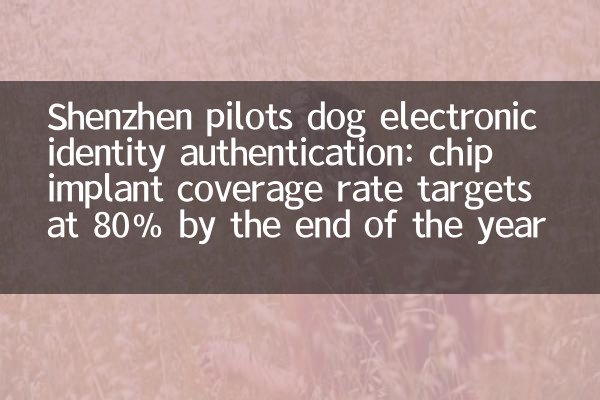Shenzhen pilots dog electronic identity authentication: chip implant coverage rate targets at 80% by the end of the year
In recent years, with the rapid development of the pet economy, urban dog management problems have become increasingly prominent. In order to standardize dog raising behavior and improve management efficiency, Shenzhen took the lead in piloting electronic dog identity authentication, and achieved traceability of dog identity through chip implantation technology. According to the latest policies, Shenzhen plans to achieve a coverage rate of 80% of dog chip implantation by the end of 2023, which has attracted widespread attention.
1. Policy background and goals

As one of the first pilot cities in the country, Shenzhen City will gradually implement dog electronic identity authentication from 2021. The policy aims to solve the pain points in traditional dog management, including the difficulty in tracking lost dogs and the difficulty in supervising illegal dog raising. By implanting a micro chip, each dog will have a unique electronic ID card and the relevant information will be entered into the city's unified database.
| Time node | Coverage target | Main measures |
|---|---|---|
| Pilot launch in 2021 | 30% | Promotion of key areas |
| Expand the scope in 2022 | 50% | Community publicity + free implantation |
| At the end of 2023 | 80% | Mandatory requirements in the entire jurisdiction |
2. Chip technical details and security
The dog electronic chip adopts the internationally universal ISO 11784/11785 standard, and is only the size of rice grains. The implantation site is subcutaneous to the neck. Chip storage information includes:
| Information Category | Specific content |
|---|---|
| Basic information | Dog breed, gender, date of birth |
| Master information | Name, contact information, address |
| Epidemic prevention records | Rabies vaccination time and organization |
The official emphasized that the chip adopts a passive design and is only activated during scanning and will not affect the health of the dog. Data transmission is encrypted to ensure privacy and security.
3. Citizen response and implementation difficulties
According to a survey by the Shenzhen Urban Management Bureau, about 65% of dog owners support electronic identity authentication, believing that it can effectively reduce abandonment and disputes. However, some citizens are also worried about the pain and later maintenance of chip implants. The following are the results of recent sampling surveys:
| Groups interviewed | Support rate | Main concerns |
|---|---|---|
| Young dog owner (18-35 years old) | 78% | Technical stability |
| Middle-aged and elderly dog owners (over 50 years old) | 42% | Operational complexity |
| Non-dog resident | 91% | Hope to strengthen management |
During the implementation process, the registration rate of some urban village dogs is low, and coverage rate needs to be increased through mobile service vehicles and other means.
4. National promotion potential and industry impact
Shenzhen’s pilot experience has attracted the attention of more than 20 cities including Beijing and Shanghai. The pet medical industry predicts that if promoted nationwide, the market size of chips and related equipment will exceed 1 billion yuan. New opportunities may also be seen in derivative fields such as pet insurance and smart collars.
Experts suggest that in the future, AI recognition technology can be combined with AI recognition technology to establish a dual certification system of "dog face recognition + chip" to further reduce management costs. At the same time, it is necessary to improve supporting regulations, clarify the boundaries of chip information use, and prevent data abuse.
The Shenzhen Municipal Urban Management Bureau stated that the phased results will be announced by the end of the year and the follow-up policies will be adjusted depending on the situation. This exploration may become a milestone in urban pet management in China.

check the details

check the details